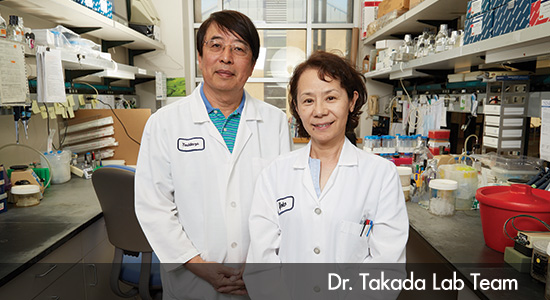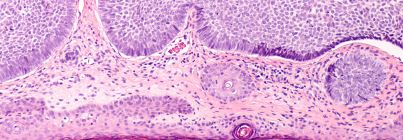Dr. Takada Research Lab
Professor

Research Interests: Integrins, cellular processes that promote inflammation, understanding how integrin-binding results in pro-inflammatory signals.
UC Davis Department of Dermatology
Research III Ste. 3300, 4645 Second Ave.,
Sacramento, CA 95817
E-mail: ytakada@ucdavis.edu
Biography
Previous work of the PI in integrin biology.
Yoshikazu Takada, M.D., Ph.D. was involved in identifying and characterizing several of the â1 integrins (VLA proteins) in the 1980s. He cloned the α2, α3, and α4 subunits and identified collagen, laminin, and vascular cell adhesion molecule-1 as their respective ligands. Dr. Takada also performed structure-function studies of several integrins using site-directed mutagenesis, particularly in the putative ligand-binding sites of integrins. His results were consistent with the crystal structure of the integrin αvβ3-RGD complex and helped interpret the integrin structure. Dr. Takada currently focuses on integrin-growth factor crosstalk. His group discovered the direct binding of integrins to FGF1, and determined that this interaction plays a critical role in FGF signaling. Most recently, they discovered that IGF-1 (insulin-like growth factor-1) directly binds to integrins and this interaction is involved in IGF/IGF1R signaling. These findings suggest that direct integrin binding is involved in growth factor signaling. It has been well established that integrins are involved in growth factor signaling, since antagonists to integrins suppress growth factor signaling. Dr. Takada’s current model of growth factor-integrin crosstalk is that 1) integrins interact with extracellular matrix (ECM) and growth factors bind to growth factor receptors, and 2) two separate signals merge together inside the cells to induce intracellular signals. He proposes that direct integrin binding to growth factors (e.g., IGF, neuregulin and FGF) plays a role in the crosstalk.

Left to right:
Yoshikazu Takada, PhD
Yoko Takada, SRA 3
Takada Lab continues working on the role of integrins in growth factor signaling including other growth factors. We are trying to generate something useful for wound healing, or treating inflammation and cancer.

The direct binding of insulin-like growth factor-1 (IGF-1) to integrin αvβ3 is involved in IGF-1 signaling
It has been proposed that ligand occupancy of integrin αvβ3 with extracellular matrix ligands (e.g., vitronectin) plays a critical role in insulin-like growth factor-1 (IGF-1) signaling. We found that expression of αvβ3 enhanced IGF-1-induced proliferation of CHO cells in serum-free conditions (in the absence of vitronectin). We hypothesized that the direct integrin binding to IGF-1 may play a role in IGF-1 signaling. We demonstrated that αvβ3 specifically and directly bound to IGF-1 in cell adhesion, ELISA-type binding, and surface plasmon resonance studies. We localized the amino acid residues of IGF-1 that are critical for integrin binding by docking simulation and mutagenesis. We found that mutating two Arg residues at positions 36 and 37 in the C-domain of IGF-1 to Glu (the R36E/R37E mutation) effectively reduced integrin binding. Interestingly, while the mutant still bound to IGF1R, it was defective in inducing IGF1R phosphorylation, AKT and ERK1/2 activation, and cell proliferation. Furthermore wild-type IGF-1 mediated co-precipitation of αvβ3 and IGF1R, while the R36E/R37E mutant did not, suggesting that IGF-1 mediates the interaction between αvβ3 and IGF1R. These results suggest that the direct binding to IGF-1 to integrin αvβ3 plays a role in IGF-1 signaling through ternary complex formation (αvβ3-IGF-IGF1R), and integrin-IGF-1 interaction is a novel target for drug discovery. (Fig. 1)
Direct binding of integrin αvβ3 to FGF-1 plays a role in FGF1 Signaling
We discovered that fibroblast growth factor (FGF)-1 directly bound to soluble and cell–surface integrin avb3 (KD about 1 mM). Antagonists to avb3 (monoclonal antibody 7E3 and cyclic RGDfV) blocked this interaction. avb3 was a predominant, if not only, integrin that bound to FGF-1, since FGF1 only weakly bound to several b1 integrins tested. We presented evidence that the CYDMKTTC sequence (the specificity loop) within the ligand-binding site of b3 plays a role in FGF-1 binding. We found that the integrin-binding site of FGF-1 overlaps with the heparin-binding site, but is distinct from the FGFR-binding site using docking simulation and mutagenesis. We identified an FGF-1 mutant (R50E) that was defective in integrin binding, but still bound to heparin and FGFR. R50E was defective in inducing DNA synthesis, cell proliferation, cell migration and chemotaxis, suggesting that the direct integrin binding to FGF-1 is critical for FGF signaling. Nevertheless R50E induced phosphorylation of FGFR1 and FRS2a, and activation of AKT and ERK1/2. These results suggest that the defect in R50E in FGF signaling is not in the initial activation of FGF signaling pathway components, but in the later steps in FGF signaling. We propose that R50E is a useful tool to identify the role of integrins in FGF signaling. (Fig. 2)
Fig. 1. Docking simulation of IGF-1- αvβ3 interaction

a). A model of IGF-1-integrin interaction. Docking simulation of the interaction between IGF-1 and integrin αvβ3 (PDB code 1L5G) was performed using AutoDock3. The headpiece of 1L5G was used as a receptor. The pose in the cluster 1 with the lowest docking energy –19.46 Kcal/mol is shown. This pose represents the most stable pose of 1GF1 when IGF-1 interacts with integrin αvβ3.
b). Positions of several amino acid residues at the predicted interface between IGF-1 and αvβ3. Arg36 and Arg37 within the predicted integrin-binding site in IGF-1 were selected for mutagenesis. Amino acid residues in MIDAS (the metal ion dependent adhesive site) (Asp119, Ser121, Ser123, Glu220, and Asp251) in b3 (red) and the specificity loop (light blue) are predicted to be close to IGF-1 (blue) in the IGF-1-integrin complex, but not directly interact with Arg36/Arg37. Arg36 and Arg37 are predicted to be close to Asp150, Tyr178, and Asp218 of av (green).
c). Arg36 and Arg37 are distinct from IGFBP4-binding site in IGF-1. Positions of Arg36 and Arg37 are shown in the IGF-1-IGFBP4 complex (PDB code 1WQJ). Tyr residues at positions 24, 31, and 60 of IGF-1 that are critical for IGF1R (pink) binding are also shown.
1.The Use of One-Bead One-Compound Combinatorial Library Technology to Discover High-Affinity {alpha}v{beta}3 Integrin and Cancer Targeting Arginine-Glycine-Aspartic Acid Ligands with a Built-in Handle.
Xiao W, Wang Y, Lau EY, Luo J, Yao N, Shi C, Meza L, Tseng H, Maeda Y, Kumaresan P, Liu R, Lightstone FC, Takada Y, Lam KS.
Mol Cancer Ther. 2010 Sep 21. [Epub ahead of print]PMID: 20858725
2. Direct Binding of the EGF-like Domain of Neuregulin-1 to Integrins ({alpha}v{beta}3 and {alpha}6{beta}4) Is Involved in Neuregulin-1/ErbB Signaling.
Ieguchi K, Fujita M, Ma Z, Davari P, Taniguchi Y, Sekiguchi K, Wang B, Takada YK, Takada Y.
J Biol Chem. 2010 Oct 8;285(41):31388-98.
3. A novel fibroblast growth factor-1 (FGF1) mutant that acts as an FGF antagonist.
Yamaji S, Saegusa J, Ieguchi K, Fujita M, Takada YK, Takada Y.
PLoS One. 2010 Apr 21;5(4):e10273.PMID: 20422052
4. A T cell-binding fragment of fibrinogen can prevent autoimmunity.
Takada Y, Ono Y, Saegusa J, Mitsiades C, Mitsiades N, Tsai J, He Y, Maningding E, Coleman A, Ramirez-Maverakis D, Rodriquez R, Takada Y, Maverakis E.
J Autoimmun. 2010 Jun;34(4):453-9. Epub 2009 Dec 24.PMID: 20036106
5. The direct binding of insulin-like growth factor-1 (IGF-1) to integrin alphavbeta3 is involved in IGF-1 signaling.
Saegusa J, Yamaji S, Ieguchi K, Wu CY, Lam KS, Liu FT, Takada YK, Takada Y.
J Biol Chem. 2009 Sep 4;284(36):24106-14. Epub 2009 Jul 3.PMID: 19578119
6. Fibrinogen-gamma C-terminal fragments induce endothelial barrier dysfunction and microvascular leak via integrin-mediated and RhoA-dependent mechanism.
Guo M, Daines D, Tang J, Shen Q, Perrin RM, Takada Y, Yuan SY, Wu MH.
Arterioscler Thromb Vasc Biol. 2009 Mar;29(3):394-400. Epub 2009 Jan 2.PMID: 19122172
7. Discovery of targeting ligands for breast cancer cells using the one-bead one-compound combinatorial method.
Yao N, Xiao W, Wang X, Marik J, Park SH, Takada Y, Lam KS.
J Med Chem. 2009 Jan 8;52(1):126-33.PMID: 19055415
8. Pro-inflammatory secretory phospholipase A2 type IIA binds to integrins alphavbeta3 and alpha4beta1 and induces proliferation of monocytic cells in an integrin-dependent manner.
Saegusa J, Akakura N, Wu CY, Hoogland C, Ma Z, Lam KS, Liu FT, Takada YK, Takada Y.
J Biol Chem. 2008 Sep 19;283(38):26107-15. Epub 2008 Jul 17.PMID: 18635536
9. Direct binding of integrin alphavbeta3 to FGF1 plays a role in FGF1 signaling.
Mori S, Wu CY, Yamaji S, Saegusa J, Shi B, Ma Z, Kuwabara Y, Lam KS, Isseroff RR, Takada YK, Takada Y.
J Biol Chem. 2008 Jun 27;283(26):18066-75. Epub 2008 Apr 25.PMID: 18441324
10. Inhibition of tissue factor signaling suppresses tumor growth.
Versteeg HH, Schaffner F, Kerver M, Petersen HH, Ahamed J, Felding-Habermann B, Takada Y, Mueller BM, Ruf W.
Blood. 2008 Jan 1;111(1):190-9. Epub 2007 Sep 27.PMID: 17901245
11. The integrins.
Takada Y, Ye X, Simon S.
Genome Biol. 2007;8(5):215. Review.PMID: 17543136
12. Rotavirus-neutralizing antibodies inhibit virus binding to integrins alpha 2 beta 1 and alpha 4 beta 1.
Fleming FE, Graham KL, Taniguchi K, Takada Y, Coulson BS.
Arch Virol. 2007;152(6):1087-101. Epub 2007 Feb 23.PMID: 17318737
13. The COOH-terminal globular domain of fibrinogen gamma chain suppresses angiogenesis and tumor growth.
Akakura N, Hoogland C, Takada YK, Saegusa J, Ye X, Liu FT, Cheung AT, Takada Y.
Cancer Res. 2006 Oct 1;66(19):9691-7.PMID: 17018627
14. Combinatorial chemistry identifies high-affinity peptidomimetics against alpha4beta1 integrin for in vivo tumor imaging.
Peng L, Liu R, Marik J, Wang X, Takada Y, Lam KS.
Nat Chem Biol. 2006 Jul;2(7):381-9. Epub 2006 Jun 11.PMID: 16767086
15. Rotavirus spike protein VP5* binds alpha2beta1 integrin on the cell surface and competes with virus for cell binding and infectivity.
Graham KL, Takada Y, Coulson BS.
J Gen Virol. 2006 May;87(Pt 5):1275-83.PMID: 16603530
16. Direct interaction of the kringle domain of urokinase-type plasminogen activator (uPA) and integrin alpha v beta 3 induces signal transduction and enhances plasminogen activation.
Tarui T, Akakura N, Majumdar M, Andronicos N, Takagi J, Mazar AP, Bdeir K, Kuo A, Yarovoi SV, Cines DB, Takada Y.
Thromb Haemost. 2006 Mar;95(3):524-34.PMID: 16525582
17. Non-cytotoxic cobra cardiotoxin A5 binds to alpha(v)beta3 integrin and inhibits bone resorption. Identification of cardiotoxins as non-RGD integrin-binding proteins of the Ly-6 family.
Wu PL, Lee SC, Chuang CC, Mori S, Akakura N, Wu WG, Takada Y.
J Biol Chem. 2006 Mar 24;281(12):7937-45. Epub 2006 Jan 10.PMID: 16407244
18. Rotaviruses interact with alpha4beta7 and alpha4beta1 integrins by binding the same integrin domains as natural ligands.
Graham KL, Fleming FE, Halasz P, Hewish MJ, Nagesha HS, Holmes IH, Takada Y, Coulson BS.
J Gen Virol. 2005 Dec;86(Pt 12):3397-408.PMID: 16298987
19. ADAM12-mediated focal adhesion formation is differently regulated by beta1 and beta3 integrins.
Thodeti CK, Fröhlich C, Nielsen CK, Takada Y, Fässler R, Albrechtsen R, Wewer UM.
FEBS Lett. 2005 Oct 24;579(25):5589-95. Epub 2005 Sep 28.PMID: 16213489


